1.2.1 HBS Human Body Systems PLTW WCHS Mr. Alasti
1/80
There's no tags or description
Looks like no tags are added yet.
Name | Mastery | Learn | Test | Matching | Spaced |
|---|
No study sessions yet.
81 Terms
What forms the cross bridge?
Myosin head
What is the basic functional unit of muscle?
The sarcomere
What is the sarcomere made of?
Thick myosin filaments and thin actin filaments
What do myosin and actin filaments do within the sarcomere?
Slide past each other
Neuromuscular junction
The specialized synapse where a motor neuron communicates with a muscle fiber to control muscle contraction
What are Z lines ?
Thin actin filaments that are attached to the ends of the sarcomere
What are M lines?
Thick myosin filaments that are attached to the center of the sarcomere
The sliding filament theory
Explains muscle contraction, stating that the thin actin filaments and thick myosin filaments within a sarcomere slide past each other, causing the sarcomere to shorten and the muscle to contract
What do the thick and thin filaments do when a muscle contracts?
Slide past each other so the muscle shortens, but the filaments stay the same length
What is the main responsibility of the myosin head?
To generate movement
How are thick filaments made?
The myosin’s tail attaches to tails of other myosin molecules
How are thick filaments held in place?
By a spring like molecule called titin
What happens from changes to the myosin head’s ATP?
Repeated cross bridging with actin filaments
What happens during each ATP binding, hydrolysis, and release?
The head moves along the actin filament in one direction to the next binding site
Hydrolysis
A chemical reaction where water breaks down a compound into smaller parts by inserting its hydrogen and hydroxyl groups across a bond
True or False: Heads are only attached to actin for a very short time in each cycle?
True
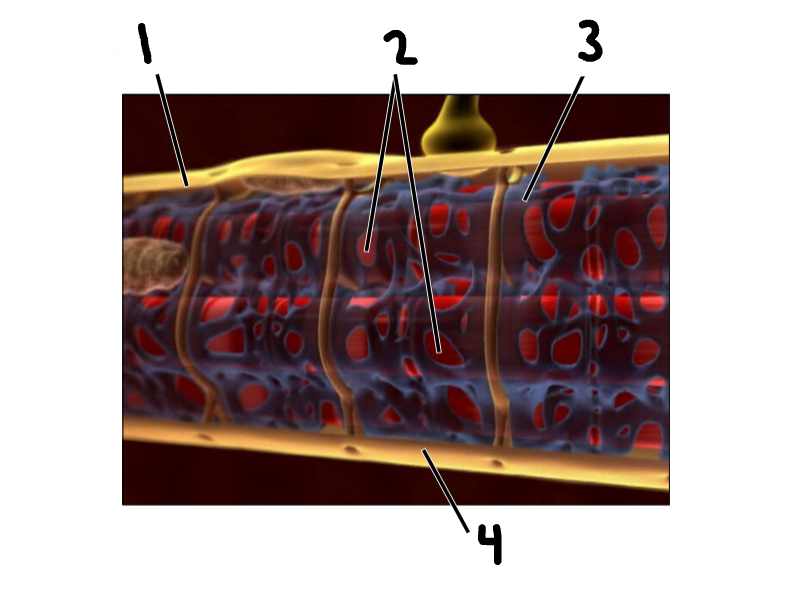
Label the image
Muscle Fiber
Myofibrils
Endoplasmic Reticulum (ER)
Plasma Membrane
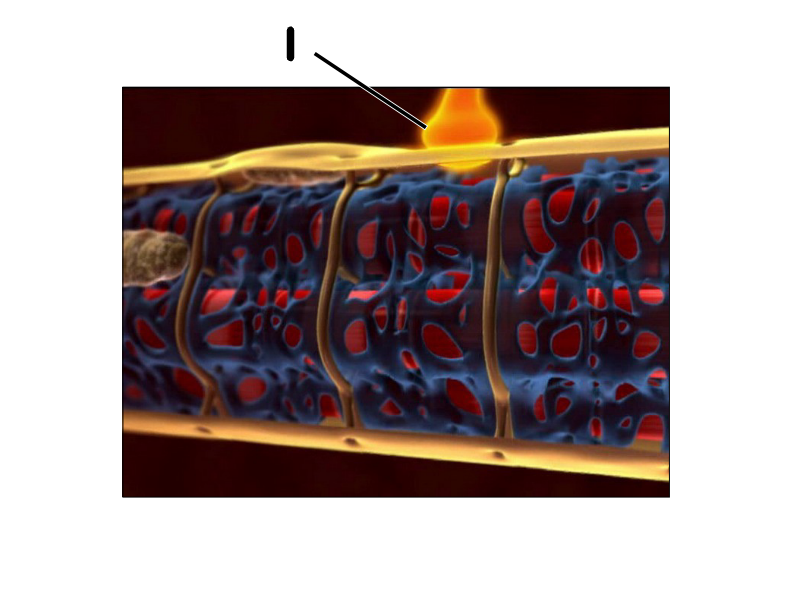
Label the image
Action potential
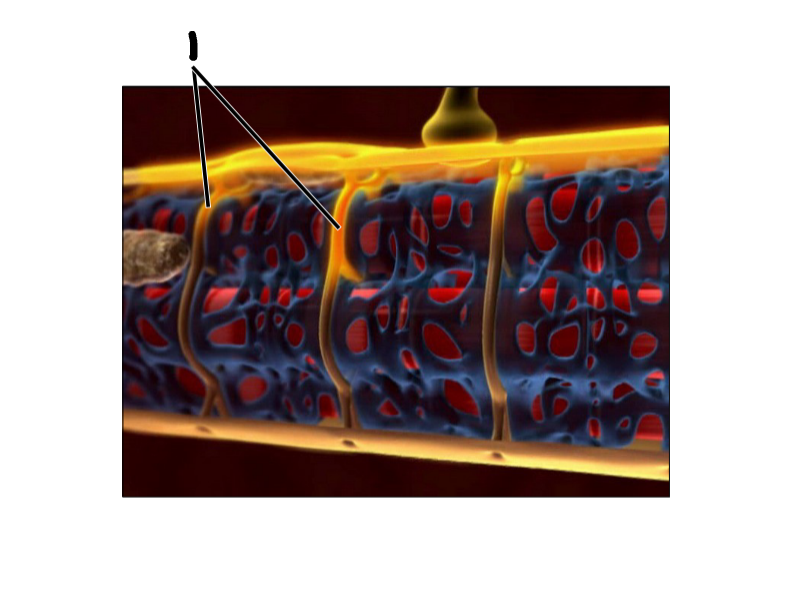
Label the image
Tubules
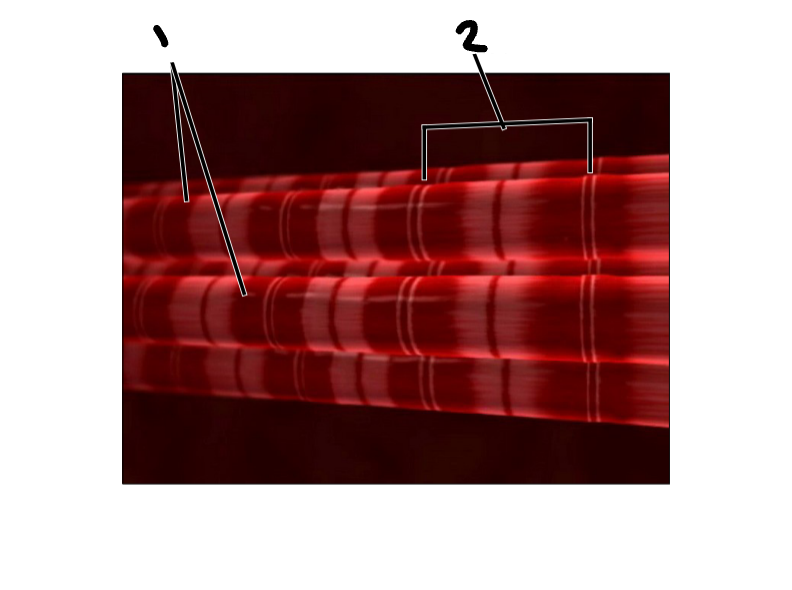
Label the image
Myofibrils (relaxed)
Sarcomere
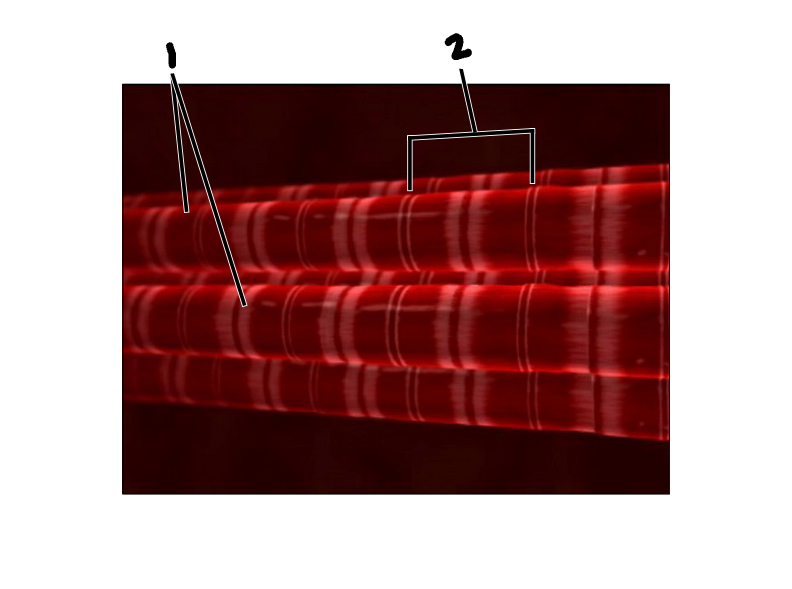
Label the image
Myofibrils (contracted)
Sarcomere
What level of biological organization is muscle?
Organ
Muscle
An organ composed of one of the three types of fibrous tissue (skeletal, cardiac, and smooth), specialized for contraction to produce voluntary and involuntary movements of parts of the body
How are muscles attached to bones?
Through tough cords or sheets of connective tissue called tendons, and these bones meet at other joints
What process pulls on bones and moves the body?
Contraction or shortening of muscles
Contraction
A process leading to shortening and/or development of tension in muscle tissue
What are the three types of muscle tissue?
Skeletal, smooth, and cardiac
Skeletal muscle tissue
An organ specialized for contraction, composed of striated muscle fibers (cells), supported by connective tissue, attached to bone by a tendon, and stimulated by somatic motor neurons
Cardiac muscle tissue
Striated muscle fibers that form the wall of the heart. They are stimulated by the intrinsic conduction system and autonomic motor neurons
Smooth muscle tissue
A tissue specialized for contraction, composed of smooth muscle fibers, located in the walls of hollow internal organs, and innervated by the autonomic motor neurons
Which muscle tissues are striated?
Skeletal and cardiac
Which muscle tissues are voluntary control?
Skeletal
Which muscle tissues are involuntary control?
Smooth and cardiac
How many nuclei does skeletal muscle tissue have?
Many
How many nuclei does smooth muscle tissue have?
One
How many nuclei does cardiac muscle tissue have?
One
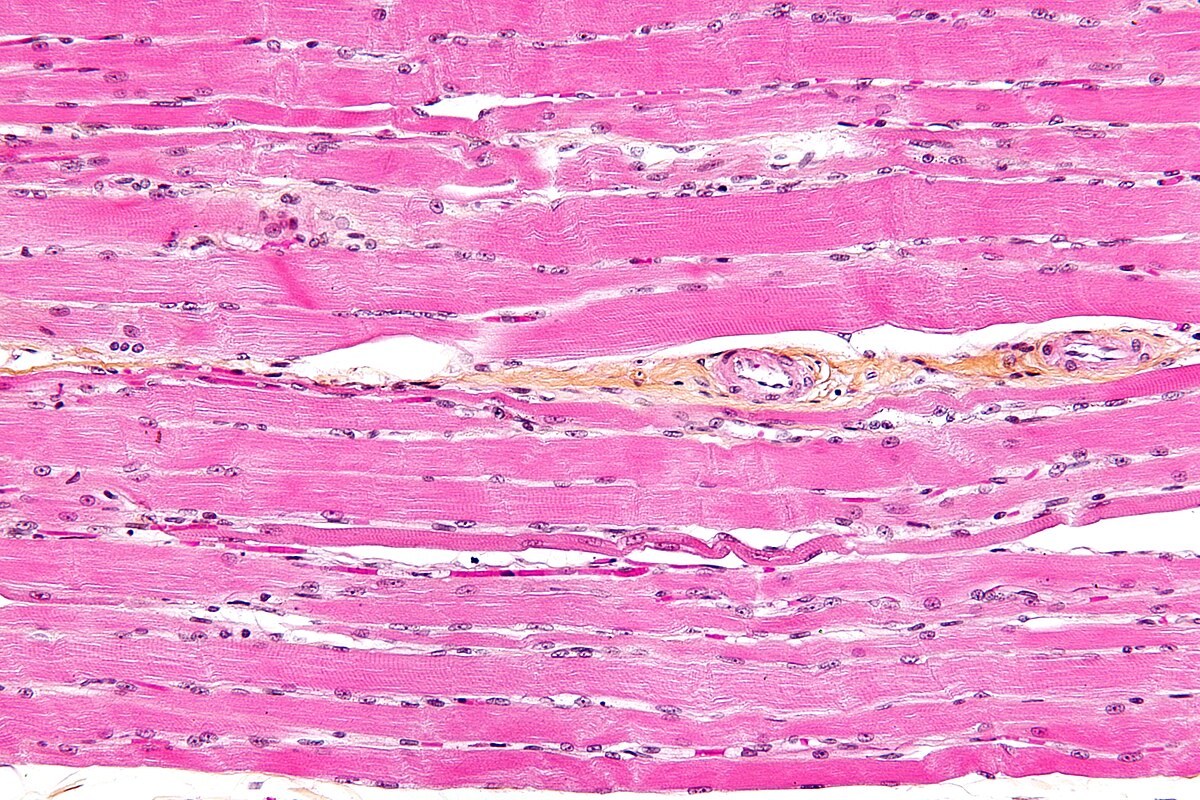
What type of tissue is this?
Skeletal
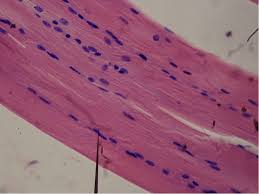
What type of tissue is this?
Smooth muscle tissue
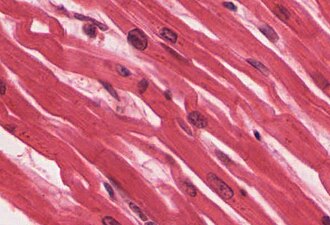
What type of tissue is this?
Cardiac muscle tissue
What generates the needed force to move the skeleton?
The contraction of a muscle
What triggers a muscle contraction?
A series of molecular events known as the cross bridge cycle
What takes place when a sarcomere shortens?
Myosin heads within thick myofilaments form cross bridges with actin molecules in thin myofilaments
What initiates the formation of a cross bridge?
When calcium ions (released from the sarcoplasmic reticulum) bind to troponin, which causes the troponin to change shape
What happens when troponin connects with a calcium ion?
Tropomyosin moves away from the myosin binding sites on actin, which allows the myosin head to bind with the actin, forming a cross bridge
True or false: The myosin head must be activated before a crossbridge cycle can begin
True
How does a myosin head become activated?
ATP binds to the myosin head, and is hydrolized to ADP and an inorganic phosphate. The energy taken from the hydrolysis of ATP activates the myosin head, which forces it into the cocked position
What are the four steps of the cross bridge cycle?
Cross Bridge Formation- activated myosin head binds to actin, forming a cross bridge, phosphate is released, and the binding between myosin and actin becomes stronger
Power Stroke- ADP is released, and the activated myosin head pivots, sliding the thin myofilament toward the center of the sarcomere
Cross Bridge Detachment- Another ATP binds to the myosin head, and the link between the myosin head and actin weakens, causing the myosin head to detach
Reactivation of Myosin Head- ATP is hydrolyzed to ADP and inorganic phosphate, and the energy released during hydrolysis reactivates the myosin head, returning it to the cocked position
What has to stay exposed for the cross bridge cycle to repeat?
The binding sites on actin
What happens as the cross bridge cycle repeats?
The myofilaments are pulled toward each other, and the sarcomere shortens, causing the whole muscle to contract
When does the cross bridge cycle end?
When calcium ions are actively transported back into the sarcoplasmic reticulum
What happens when troponin returns to its original shape?
Tropomyosin can glide over and cover the myosin binding site on actin
ATP
A compound composed of adenosine and three phosphate groups that supplies energy for many biochemical cellular processes
What do muscle fibers need in order to shorten or contract?
ATP and salt
What is the equation of percent contraction?
Original length- final length/ original length x 100
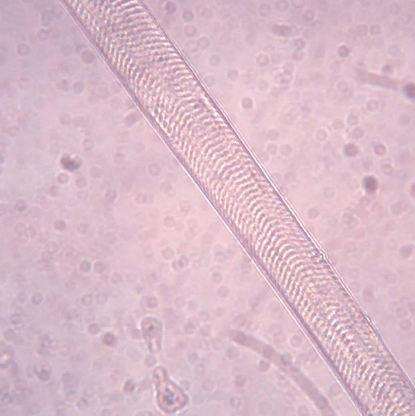
Is this muscle fiber relaxed or contracted?
Relaxed
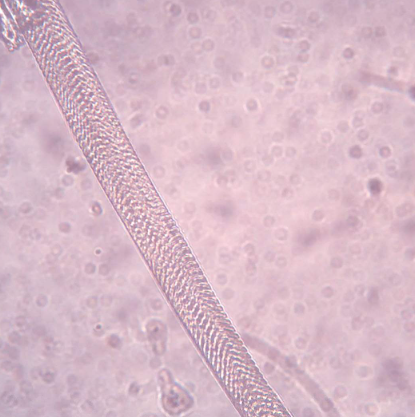
Is this muscle fiber relaxed or contracted?
Contracted
What are the main proteins that make up a sarcomere?
Myosin and actin
About how many sarcomeres does each muscle fiber contain?
Over 2000 sarcomeres, but that number can vary depending on an individual’s muscle mass and age
Location of skeletal muscle tissue
Attached to bones via tendons
Location of smooth muscle tissue
Make up the walls of the hollow internal organs
Location of cardiac muscle tissue
Walls of the heart
Describe the differences between the three types of muscle tissue
Cardiac and smooth muscle tissue have only one nucleus while skeletal has thousands. Cardiac and skeletal tissue are striated, while smooth tissue has no striations. Cardiac tissue looks almost like channels, skeletal looks like cylinders, and smooth is tightly packed together
What is happening within cells when muscle fibers shorten?
Sarcomeres shorten due to actin and myosin sliding over each other and overlapping which is mainly driven by ATP
What happens inside your muscle when you get a muscle cramp?
A nerve that controls the muscle sends an abnormal sign, which causes the muscle fibers to begin contracting. The fibers then shorten and generate force, and pain and discomfort are then caused from the muscles being contracted for an extended amount of time
What are common causes of involuntary muscle cramps?
Electrolyte imbalances, dehydration, overexertion, muscle strain, and certain medications
What must be gained for the troponin to slide from the tropomyosin and to reveal the active sites?
Calcium
If one sarcomere is contracting, are all of them?
Yes; the neuron stimulates the entire muscle fiber
True or false: Neurons do not physically touch the muscle fibers, but must be close to be stimulated
True
What happens to a muscle fiber if the neuron is too far away?
The muscle fiber gets smaller and never gets stimulated
Neuromuscular junction
The spot in which the muscle fiber and neuron are close
What is the chemical stimulus called that neurons create?
Acetylcholine
What does acetylcholine do?
It swims across the space between the neuron and muscle cell membrane (synaptic cleft), and there are receptors that accept the chemical. As soon as it lands, it creates an electric potential, causing calcium ions to be released into the sarcoplasm
How does acetylcholinesterase stop muscle contractions?
It grabs as many acetylcholine receptors as it can to stop contraction by eventually breaking it down, or returning it to the synaptic cleft of the neuron to be packaged and used again. Sarcoplasmic reticulum pumps calcium back, and the troponin doesn't have calcium anymore, placing the tropomyosin back over the active site
What has to take place for neurons to fire?
There has to be a change inside and outside that is achieved by sodium and potassium channels
What are the functions of skeletal muscles?
Produce skeletal movement
Maintain body position
Support soft tissues
Guard body openings
Maintain body temperature
How does heat get produced from skeletal muscles?
Heat that gets produced gets distributed throughout the cardiovascular system and all throughout the body
What level of organization are muscles? How?
Muscles are organs since they are made up of 2 or more tissue types (nervous, muscular, and connective)
What are the red dots within the muscle fibers?
Myofibrils
What is the blue lacy glove made up of that surrounds each sarcomere?
Sarcoplasmic reticulum
Why do muscles need more mitochondria?
Because muscles use lots of energy
When does calcium get released into the sarcoplasm?
When electrical impulses are released